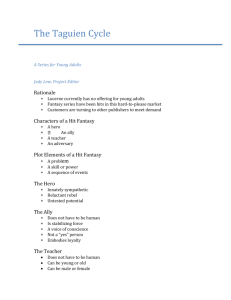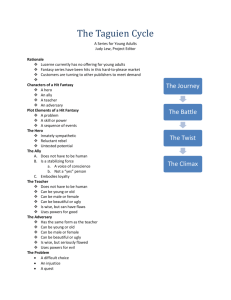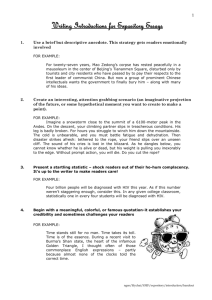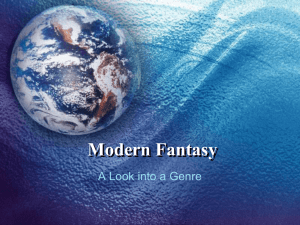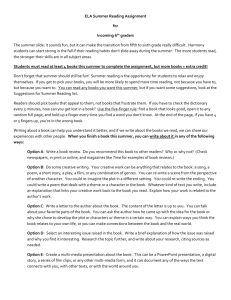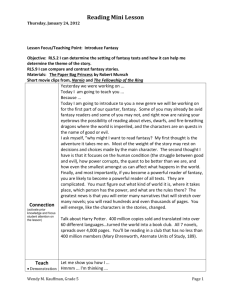Grade 5 - Farmington Public Schools
advertisement
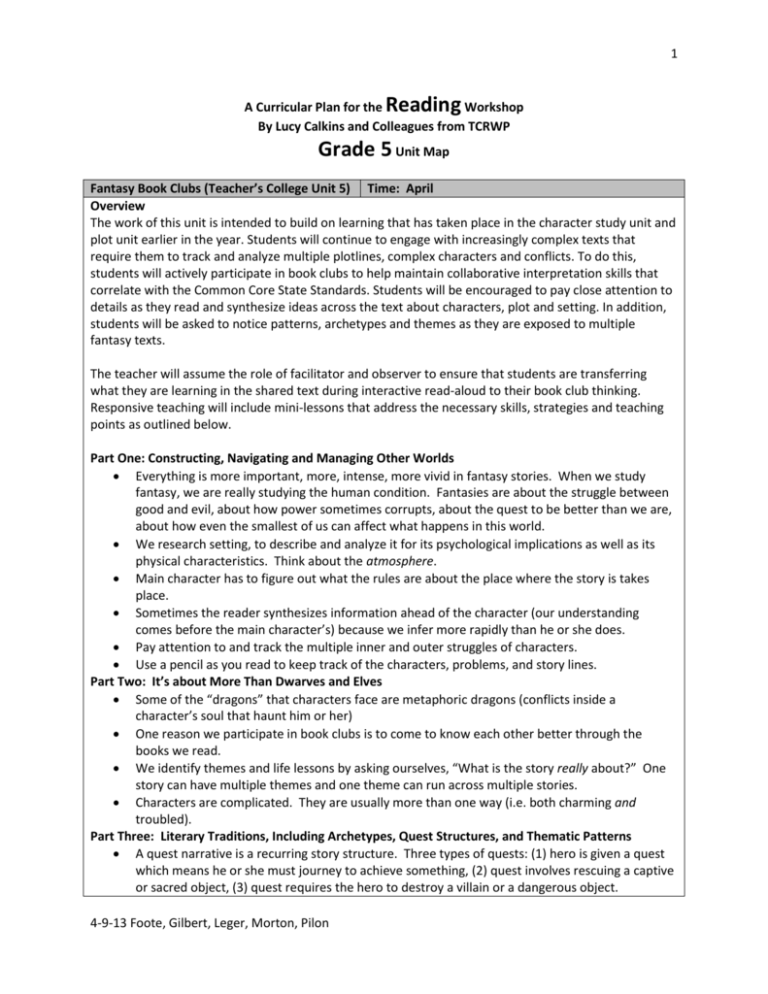
1 Reading A Curricular Plan for the Workshop By Lucy Calkins and Colleagues from TCRWP Grade 5 Unit Map Fantasy Book Clubs (Teacher’s College Unit 5) Time: April Overview The work of this unit is intended to build on learning that has taken place in the character study unit and plot unit earlier in the year. Students will continue to engage with increasingly complex texts that require them to track and analyze multiple plotlines, complex characters and conflicts. To do this, students will actively participate in book clubs to help maintain collaborative interpretation skills that correlate with the Common Core State Standards. Students will be encouraged to pay close attention to details as they read and synthesize ideas across the text about characters, plot and setting. In addition, students will be asked to notice patterns, archetypes and themes as they are exposed to multiple fantasy texts. The teacher will assume the role of facilitator and observer to ensure that students are transferring what they are learning in the shared text during interactive read-aloud to their book club thinking. Responsive teaching will include mini-lessons that address the necessary skills, strategies and teaching points as outlined below. Part One: Constructing, Navigating and Managing Other Worlds Everything is more important, more, intense, more vivid in fantasy stories. When we study fantasy, we are really studying the human condition. Fantasies are about the struggle between good and evil, about how power sometimes corrupts, about the quest to be better than we are, about how even the smallest of us can affect what happens in this world. We research setting, to describe and analyze it for its psychological implications as well as its physical characteristics. Think about the atmosphere. Main character has to figure out what the rules are about the place where the story is takes place. Sometimes the reader synthesizes information ahead of the character (our understanding comes before the main character’s) because we infer more rapidly than he or she does. Pay attention to and track the multiple inner and outer struggles of characters. Use a pencil as you read to keep track of the characters, problems, and story lines. Part Two: It’s about More Than Dwarves and Elves Some of the “dragons” that characters face are metaphoric dragons (conflicts inside a character’s soul that haunt him or her) One reason we participate in book clubs is to come to know each other better through the books we read. We identify themes and life lessons by asking ourselves, “What is the story really about?” One story can have multiple themes and one theme can run across multiple stories. Characters are complicated. They are usually more than one way (i.e. both charming and troubled). Part Three: Literary Traditions, Including Archetypes, Quest Structures, and Thematic Patterns A quest narrative is a recurring story structure. Three types of quests: (1) hero is given a quest which means he or she must journey to achieve something, (2) quest involves rescuing a captive or sacred object, (3) quest requires the hero to destroy a villain or a dangerous object. 4-9-13 Foote, Gilbert, Leger, Morton, Pilon 2 Characters have similarities across stories. They are archetypes (standard type of character). The main character is usually the hero. Common hero types include the traditional hero, the reluctant or everyday hero (ordinary person swept into great events), the anti-hero (has nonheroic traits). Other common roles include the mentor (teaches and guides the young hero), the companions (accompany the hero on the quest), the villain (may be disguised or even benevolent), the consort (love interest). Analyzing archetypes moves the reader to a deeper level of comprehension. Themes occur across many stories. Almost always about the epic struggle between good and evil and good triumphs in the end. The struggle is worth it, no matter how arduous the journey. Common theme – main character has to overcome internal struggles and embrace his or her essential goodness for good to triumph for all (self-sacrifice). Analyze stories with a critical lens – be alert to stereotypes and gender norms. Fantasy novels are grounded in particular literary traditions. During this unit: Be sure to begin this unit a week prior to launching the fantasy writing unit in order for students to be immersed in the genre. When selecting texts for book clubs, be sure to select books that have significant settings (not real-world). Be aware that most fantasy series above level M are meant to be read in order. When readers read the series in the correct order, they’re able to do the higher-level reading work of tracing character change over time, of discerning the subplots and emerging themes. Teachers should model with short, fantasy picture books (see attached list). At most, teachers should use a short fantasy book as a shared text. Picture books can also be used as mentor texts for corresponding fantasy writing unit. Students should be encouraged to create their own organizers to track characters, problems, storylines and their thinking in their notebooks. Examples may include tables, labeled sketches, timelines, charts, graphic organizers, etc. Stage 1 – Common Core State Standards and Indicators– What must students know and be able to do? Reading Literature: Key Ideas and Details 5.RL.01 - Quote accurately from a text when explaining what the text says explicitly and when drawing inferences from the text. 5.RL.02 – Determine a theme of a story, drama, or poem from details in the text, including how characters in a story or drama respond to challenges or how the speaker in a poem reflects upon a topic; summarize the text. 5.RL.03 – Compare and contrast two or more characters, settings, or events in a story or drama, drawing on specific details in the text (e.g., how characters interact). Craft and Structure 5.RL.04 - Determine the meaning of words and phrases as they are used in a text, including figurative language such as metaphors and similes. 5.RL.05 - Explain how a series of chapters, scenes, or stanzas fits together to provide the overall structure of a particular story, drama, or poem. Integration of Knowledge and Ideas 5.RL.09 – Compare and contrast stories in the same genre (e.g., mysteries and adventure stories) on their approaches to similar themes and topics. 4-9-13 Foote, Gilbert, Leger, Morton, Pilon 3 Range of Reading and Level of Text Complexity 5.RL.10 – By the end of the year, read and comprehend literature, including stories, dramas, and poetry, at the high end of the grades 4-5 text complexity band independently and proficiently. Speaking and Listening: Comprehension and Collaboration 5.SL.01 – Engage effectively in a range of collaborative discussions (one-on-one, in groups, and teacher-led) with diverse partners on grade 5 topics and texts, building on others’ ideas and expressing their own clearly. a. Come to discussions prepared, having read or studied required material; explicitly draw on that preparation and other information known about the topic to explore ideas under discussion. c. Pose and respond to specific questions by making comments that contribute to the discussion and elaborate on the remarks of others. d. Review the key ideas expressed and draw conclusions in light of information and knowledge gained from the discussions. Presentation of Knowledge and Ideas 5.WL.04 – Report on a topic or text or present an opinion, sequencing ideas logically and using appropriate facts and relevant, descriptive details to support main ideas or themes; speak clearly at an understandable pace. Essential Questions for Students Guiding Questions for Teachers What makes fantasy “fantastic”? How can I help students build and revise theories about characters by paying close attention to characters’ actions, envisioning and predicting on every page? How does the author use language to draw the reader into the imaginary world of a fantasy? What recurring themes or life lessons are often found in fantasy texts? How do readers synthesize ideas across many pages in a complex text? (close reading) How can I help students generate thematic ideas about their stories by synthesizing their thinking about the complexity of character and plot development across a text? How can I help students look across books and characters to learn lessons that apply not just in the particular context of one book, but across texts, and importantly, in real life? Stage 2– Common Assessment – What is the evidence of understanding? Universal Screens Formative Assessment Strategies Common Unit Assessment: Fantasy Book Clubs (set of exit slips, discussion evaluations, written responses) 4-9-13 Foote, Gilbert, Leger, Morton, Pilon 4 Stage 3 – Instruction – What learning experiences will lead to understanding? Skills: Key Terms/Vocabulary motivation recurring analyzing setting and its effect on interpretation critical lens character and plot plot line compare and contrast metaphor symbolism synthesizing ideas figurative language archetype inner and outer struggle theme complex analysis of characters as they epic struggle universal theme respond to multiple conflicts or struggles values and beliefs quest villain identifying themes within a text and mentor across multiple texts hero reluctant hero antihero One Possible Sequence of Teaching Points (A Note To Teachers: Please remember that this is one possible sequence of teaching points. Based on the students in your class, you may decide to spend more time on some things and less on others. This is a guide to help you make decisions based on the learners in front of you.) Part One: Constructing, Navigating and Managing Other Worlds “Friends, today I want to teach you that fantasy readers understand that their first task is to figure out what kind of setting their story takes place in. Readers look for clues about the time period and the magical elements, in particular, using the covers, blurbs, and details from the beginning of the story for their research. We know that the setting will have physical and psychological implications on the character and the story.” “Readers, today I want to teach you that in complicated stories such as these fantasy novels, often the main characters begin without a lot of knowledge, and they have a steep learning curve. When the main character is told important information or has dramatic new experiences, alert readers see those moments in the story as opportunities not just for the character to learn but for the reader to learn hand-in-hand with the main character.” “Friends, as readers tackle more complicated books, the stories will begin to have multiple plotlines. This means that the main characters will have more than one problem, that problems will arise for other characters, and that not all problems will be resolved by the end of a story. Today I want to teach you that often readers find it helpful to use charts, timelines, and other graphic organizers to track the problems that arise in a story, to closely follow the multiple plotlines, and to gather evidence sort of the way scientists do, in charts and tables that let us do close analysis.” “Readers, today I want to teach you that experienced readers have a repertoire of writingabout-reading strategies that we mine to support our reading work and our conversations. These include making visuals, sorting and analyzing Post-its and entries, experimenting with charts and flowcharts, and writing reflections. One way to extend this repertoire is for a learning community to share with each other the different ways that we use our notebooks as we read.” Part Two: It’s about More Than Dwarves and Elves “Readers, today I want to teach you that in the stories you are reading, the characters face dragons as well. Not just literal dragons, which some fantasy characters do encounter, but 4-9-13 Foote, Gilbert, Leger, Morton, Pilon 5 metaphoric dragons—these are the conflicts inside a character’s soul, which haunt that character. Powerful readers learn to think metaphorically about these ‘dragons.’” “Readers, today I want to teach you that often, with great stories, the plot is a vehicle for teaching about ideas. The stories are not just about what happens. Stories are also about themes and life-lessons. Insightful readers mine these stories for these themes and lessons.” “Readers, today I want to teach you that as the books we read become more complex, the characters also become more complicated. They are not just all evil or all good—they are nuanced. This means that powerful readers delve deeply into their characters’ strengths, flaws, and motivations across the whole arc of the story.” Part Three: Literary Traditions “Friends, today I want to teach you that fantasy novels have certain characteristics, or patterns in their structures and the character roles. One way that experienced fantasy readers analyze the stories they read, therefore, is they consider the patterns that emerge in story structure, character roles, and themes—these are part of the literary traditions of this genre.” “Readers, today I want to teach you that one way readers analyze a story is to read with critical lenses for stereotypes and gender norms (or rules). One way to do this work is to consider characters’ actions and appearances.” “Today I want to teach you that when readers have been deeply studying a genre, they may incorporate and extend this work. Some ways to do this include using the strategies they have sharpened in other genres; seeking more books, and company, to become even more expert in this genre; or moving to other genres that are similar this one.” Resources: Calkins, Lucy and Colleagues. 2011. A Curricular Plan for the Reading Workshop, Grade 5. Portsmouth, NH: Heinemann. Ehrenworth, Mary. 2011. A Quick Guide to Teaching Reading Through Fantasy Novels 5-8. Portsmouth, NH: Heinemann. Ehrenworth, Mary et al. 2010. “A Genre Study of the Complexities and Themes of Fantasy,” Constructing Curriculum: Alternate Units of Study from Units of Study for Teaching Reading: A Curriculum for the Reading Workshop, Grades 3-5. Portsmouth, NH: Heinemann. Seravallo, Jennifer. 2007. Conferring with Readers. Portsmouth, NH: Heinemann. Seravallo, Jennifer. 2010. Teaching Reading in Small Groups. Portsmouth, NH: Heinemann. Teachers College. 2008. Reading with Our Minds on Fire – Fantasy. (unit plan step-by-step) http://www.tc.edu/rwp/unitsbystudents/. Mentor Texts for Interactive Read-aloud: McMullan, Kate. Dragon Slayers’ Academy 1: The New Kid at School Munsch, Robert. The Paper Bag Princess 4-9-13 Foote, Gilbert, Leger, Morton, Pilon 6 Rodda, Emily. Deltora Quest: The Forests of Silence http://www.youtube.com/watch?v=MfyqeIRr0co (You Tube clip) Mentor Texts for Book Clubs: WWUES Book Room Collection: go to K-drive, Subject Areas, Language Arts, Book Room, Book Room Collection (excel spreadsheet – sort by genre) Suggested texts and book lists from TCRWP: http://readingandwritingproject.com/public/themes/rwproject/resources/booklists/archived/reading/g enre_fantasy.pdf Abbott, Tony. Secrets of Droon Series (M,N,O) McMullan, Kate. Dragon Slayers’ Academy Series (N,P) Black, Holly and Tony DiTerlizzi. Spiderwick Chronicles Series (Q,R) DuPrau, Jeanne. City of Ember Series (R,U) Rodda, Emily. Deltora Quest (R,T) Hunter, Erin. Warriors (R,S) Rodda, Emily. Rowan of Rin (T) Collins, Suzanne. Gregor the Overlander (V) Babbitt, Natalie. Tuck Everlasting (W) Riordan, Rick. The Lightning Thief (W) Websites and Technology: http://prezi.com/xwdwmyfc8tmm/fantasy-for-upper-elementary-school/ (prezi presentation) trailers or clips from fantasy movies such as How to Train Your Dragon, Harry Potter, Narnia 4-9-13 Foote, Gilbert, Leger, Morton, Pilon
